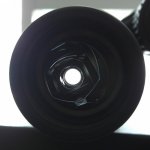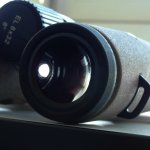This SV 10x50 seems to be an awesome binocular. And these huge ocular lenses! It's something like fujinon 10x50 FMTR-SX but with more useful eye relief. I read somewhere that Fujinons have only 13mm useful eye relief because of deeply recessed lenses, and therefore doesn't work very well with eyeglasses despite the size if the lenses. But the Swarovski SV 10x50 propably is wonderful in this respect!
-
Welcome to BirdForum, the internet's largest birding community with thousands of members from all over the world. The forums are dedicated to wild birds, birding, binoculars and equipment and all that goes with it.
Please register for an account to take part in the discussions in the forum, post your pictures in the gallery and more.
You are using an out of date browser. It may not display this or other websites correctly.
You should upgrade or use an alternative browser.
You should upgrade or use an alternative browser.
10X50 Swarovision (1 Viewer)
- Thread starter Pileatus
- Start date
More options
Who Replied?Dale Forbes
Swarovski Optik, Austria

Hi Holger
I think that's the thing I find so enjoyable about the El 10X42 SV. Among all of the other nice things I see through them, a full "locked in" view, without any kind of blackouts, with my eyeglasses on is noteworthy . I don't work to get it, it's just there. It makes a viewing session very relaxing and enjoyable. Is this all just a happy accident, or did Swarovski actually " fine tune" all of these parameters to achieve an easier view with less user fatigue?
paramount to the ease of view of a pair of binoculars is the size of the edge bundle (Randpupille), a metric/property that I cannot ever remember having seen mentioned or explored on BirdForum. Naturally, the other factors, like the exit pupil diameter and eyecup shape, mentioned above, will also influence how easy it is to find the image. Said optical viewing comfort is obviously not a completely independent parameter and - for example - the easiest way to increase the field of view of our binoculars would be to sacrifice some of the edge bundle. This makes for a great improvement of the technical data sheet and impressive to look through, but would come at a very real cost to viewing comfort.
A few reasons I made it.I meant the wood type mount that the binocular is mounted on.
1. The Swaro mount is cumbersome to use because you have to "load" the strap before the binocular is secured. That simply doesn't work with a ball grip, at the end of a monopod pivoting on a tripod.
2. I wanted to be able to adjust the IPD with ease, during use.
3. I did not want any failures in the darkness of night.
The latest modification includes a narrower support bolt to accommodate the full range of IPD's on my 42/50 SV's and an extra wing nut attached to the mount in case I lose one.
The "weakest link" in the system is the quick release plate, something I trust completely, as long as it's locked.
Last edited:
mooreorless
Well-known member
Thanks for your reply! That is a very interesting home made device. Looks like it should work very well! I have the Nikon Binoc-U-Mount and while it works ok, it does give quite a bit if using a higher power binocular and some larger binocular do not fit in the mount.
I should note mine only works with open bridge bins like the Swaros. I use the very simple and well-designed Nikon mount for our SE's.Thanks for your reply! That is a very interesting home made device. Looks like it should work very well! I have the Nikon Binoc-U-Mount and while it works ok, it does give quite a bit if using a higher power binocular and some larger binocular do not fit in the mount.
mooreorless
Well-known member
I have the same mount for my SE and I agree well-designed and it more rigid compared to the binocu-mount. Thanks for you thoughts on the 10x50 SV. Makes me want to get one.
dalat
...

paramount to the ease of view of a pair of binoculars is the size of the edge bundle (Randpupille), a metric/property that I cannot ever remember having seen mentioned or explored on BirdForum.
Hi Dale, I also can't remember having seen this term, what does it mean?
elkcub
Silicon Valley, California

paramount to the ease of view of a pair of binoculars is the size of the edge bundle (Randpupille), a metric/property that I cannot ever remember having seen mentioned or explored on BirdForum. Naturally, the other factors, like the exit pupil diameter and eyecup shape, mentioned above, will also influence how easy it is to find the image. Said optical viewing comfort is obviously not a completely independent parameter and - for example - the easiest way to increase the field of view of our binoculars would be to sacrifice some of the edge bundle. This makes for a great improvement of the technical data sheet and impressive to look through, but would come at a very real cost to viewing comfort.
Hi Dale,
This sounds very interesting. Can you provide an optical reference (in English) for Randpupille?
Ed
bh46118
Well-known member
Hi Dale
Thanks so much for your comments pertaining to my post. I feel very fortunate to own my El 10X42 SV. They are in my opinion, stunning.:t:
Bruce
Thanks so much for your comments pertaining to my post. I feel very fortunate to own my El 10X42 SV. They are in my opinion, stunning.:t:
Bruce
paramount to the ease of view of a pair of binoculars is the size of the edge bundle (Randpupille), a metric/property that I cannot ever remember having seen mentioned or explored on BirdForum. Naturally, the other factors, like the exit pupil diameter and eyecup shape, mentioned above, will also influence how easy it is to find the image. Said optical viewing comfort is obviously not a completely independent parameter and - for example - the easiest way to increase the field of view of our binoculars would be to sacrifice some of the edge bundle. This makes for a great improvement of the technical data sheet and impressive to look through, but would come at a very real cost to viewing comfort.
Dale Forbes
Swarovski Optik, Austria

Hi Dale,
This sounds very interesting. Can you provide an optical reference (in English) for Randpupille?
Ed
It is fascinating, but I have yet to find anything useful in English but I will keep my eyes open for there is surely an optics textbook somewhere that looks in to this. As you could imagine, a lot of our understanding of how optics work and how everything hangs together (interlinked parameters, the eye, perception) has been built up internally over the years, with very little work being published.
Vespobuteo
Well-known member
I think there are many parameters involved in creating a relaxed view: Exit pupil, resolution, light gathering capacity/objective lens size, brightness/transmission, contrast, size/design of the eye piece/eye relief, FOV, AFOV, edge to edge sharpness, depth of field, field curvature, magnification, weight and possibly more.
bh46118
Well-known member
That is the real pathway to true optical advancement. All elements brought together to create a more complete, more wholistic viewing experience. Many models have strong points in one or two areas, only a handful are outstanding in most areas. Swarovski does this better than anyone at the present moment, but I guess we'll see if the SF can add large FOV without doing harm to the overall balance of the image. My opinion of course.
I think there are many parameters involved in creating a relaxed view: Exit pupil, resolution, light gathering capacity/objective lens size, brightness/transmission, contrast, size/design of the eye piece/eye relief, FOV, AFOV, edge to edge sharpness, depth of field, field curvature, magnification, weight and possibly more.
Last edited:
dalat
...

It is fascinating, but I have yet to find anything useful in English but I will keep my eyes open for there is surely an optics textbook somewhere that looks in to this.
Hi Dale, a reference in German or simply a short explanation from yourself, what "Randpupille" is, would certainly also be interesting...
bh46118
Well-known member
In English it means Dilated Pupil Size.
Hi Dale, a reference in German or simply a short explanation from yourself, what "Randpupille" is, would certainly also be interesting...
Last edited:
elkcub
Silicon Valley, California

In English it means means Dilated Pupil Size.
I think it means "edge of the pupil," or pupil edge.
Ed
Holger Merlitz
Well-known member
It is fascinating, but I have yet to find anything useful in English but I will keep my eyes open for there is surely an optics textbook somewhere that looks in to this. As you could imagine, a lot of our understanding of how optics work and how everything hangs together (interlinked parameters, the eye, perception) has been built up internally over the years, with very little work being published.
Hi Dale,
Thanks for drawing attention to that term, which so far I haven't been aware of. I may only guess: When looking into the eyepiece from a distance, we see the exit pupil, and while shifting the head to the side, this exit pupil gradually moves toward the edge of the ocular's eye-lens, while increasingly becoming vignetted. I could imagine that this thing might be called "Randpupille". I have added two pictures for illustration. In some binoculars, in which the prisms are undersized, this vignetting of the Randpupille is extreme, and viewing then turns nervous because the reduced Randpupille easily escapes the eye-pupil once you look toward the edge of field.
Cheers,
Holger
Attachments
dalat
...

Interesting!
So this "edge pupil", the size of the exit pupil looked at from the side, could be a simple indicator for the ease of view...
We could compare some photos of bins with good ease of view and ones that are famous to be fiddely, to see if this works...
If true, allbinos can change their exit pupil photos from front view to side view and it would actually be meaningful :-O
Ps: for the translation, Ed is right, Rand = edge. Dale translated himself:
So this "edge pupil", the size of the exit pupil looked at from the side, could be a simple indicator for the ease of view...
We could compare some photos of bins with good ease of view and ones that are famous to be fiddely, to see if this works...
If true, allbinos can change their exit pupil photos from front view to side view and it would actually be meaningful :-O
Ps: for the translation, Ed is right, Rand = edge. Dale translated himself:
paramount to the ease of view of a pair of binoculars is the size of the edge bundle
Last edited:
bh46118
Well-known member
Vespobuteo
Well-known member
old (japan) porros often had squaren shaped exit pupils…
that was not optimal..

but not very common these days,
that was not optimal..
but not very common these days,
mooreorless
Well-known member
old (japan) porros often had squaren shaped exit pupils…
that was not optimal..
but not very common these days,
That would be the difference of Bak4 Prisms [round EP] and BK7 Prisms [square EP] I have had some excellent binoculars with the BK7 prisms.
Users who are viewing this thread
Total: 2 (members: 0, guests: 2)





